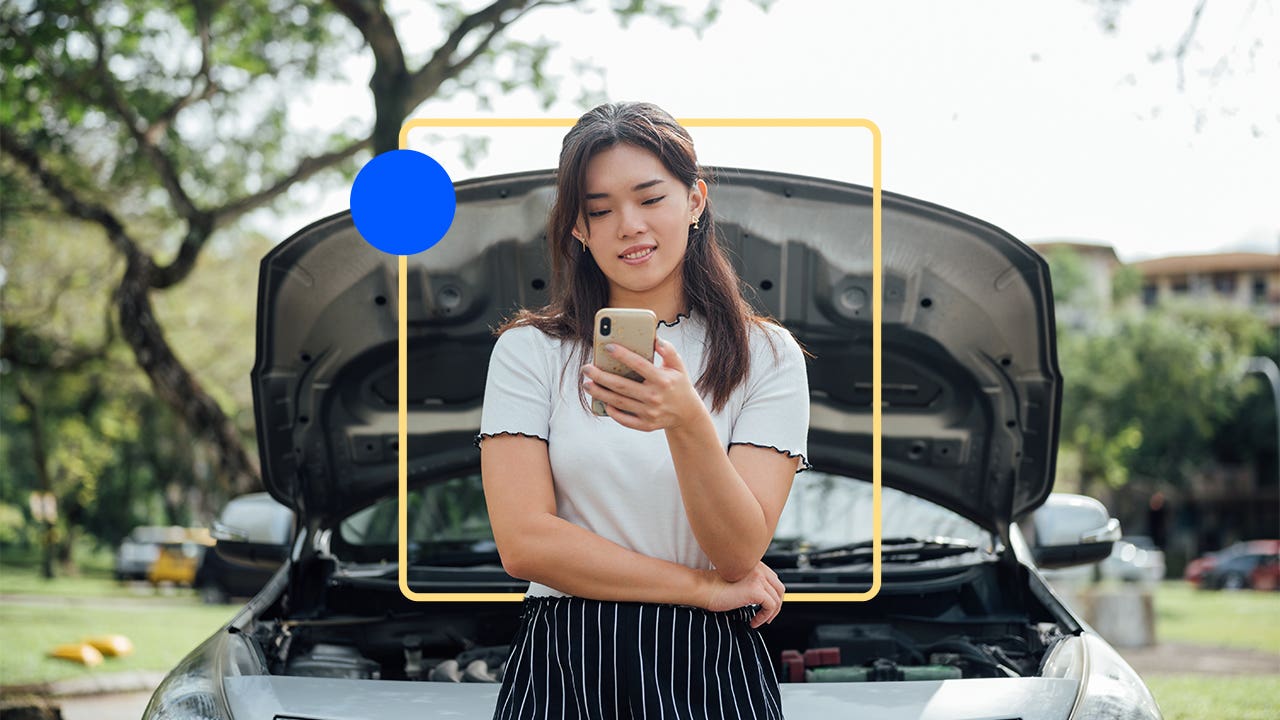The ultimate guide to roadside assistance

We put a lot of trust in our vehicles to get us to work, appointments, weekend trips and beyond, but even the best cars can have mishaps. Each year drivers also get flat tires, skid into snow drifts and lock themselves out of their vehicles. Roadside assistance can lend a hand in all of these situations. Some services will even deliver gas or offer free tows. Roadside assistance is available from various car insurance carriers and other third-party companies, but the best provider will depend on your driving habits.
What is roadside assistance?
Roadside assistance is a service offered to assist drivers, physically and financially, when their vehicle breaks down. This service or membership is typically offered for a fee.
It provides two main benefits:
- Policyholders receive emergency roadside service in the event their vehicle breaks down. Services might include fuel delivery, changing a flat tire or towing to a service center if the issue cannot be immediately resolved.
- Roadside assistance helps mitigate the cost of an unexpected breakdown. Similar to car insurance, roadside assistance policyholders pay a fee (or premium) to the service provider. When a breakdown occurs, the driver will typically not have to pay out of pocket for the emergency services they receive, as long as they are within the policy limit.
To put it in perspective, if your vehicle breaks down and needs to be towed and your roadside assistance plan covers towing, you could save a tidy sum of money. The average cost of a tow is around $109, or between $2.50 and $7 per mile, according to J.D. Power. The reporting company also notes that you may also pay additional fees for after-hours towing or if you have a large truck or other heavy vehicle. Roadside assistance may also help you avoid these charges.
What does roadside assistance cover?
When you opt for roadside assistance, the following coverage may be included:
- Towing
- Transportation assistance for a stranded driver and passengers
- Battery jumpstart
- Gas delivery
- Lockout service
- Tire change
- Winching to pull a stuck vehicle out
This is not an exhaustive list. Services vary by company.
What makes roadside assistance different from other coverage?
Roadside assistance is different from other types of coverage that you might get from a car insurance policy or manufacturer’s warranty. Basic car insurance usually covers only the cost of repairing damage from accidents, and emergency response is not typically included. Warranties will repair or replace malfunctioning parts on your new vehicle, but with the exception of a few rare cases, flat tires and empty gas tanks are not covered.
Note that you can often purchase a roadside assistance plan from your insurance provider or your vehicle’s manufacturer as an add-on to the service you currently have. Just make sure to shop around before you settle on a plan to see if you are getting the best price and service.
Learn more: Compare car insurance rates
Why is roadside assistance important?
Imagine this: you are driving in an unfamiliar location at night when suddenly, you hear the distinct pop and hiss of your tire going flat. Without roadside assistance, you might be stuck on the side of the road trying to change the tire yourself in the dark. But if you do have emergency roadside assistance, help is just a phone call away. A professional will be dispatched to your location to rescue both you and your car.
Everyone should consider roadside assistance, but it is an even more important service to have for the following people:
- Drivers who may be unfamiliar with changing a tire
- Drivers who may find it difficult to step away from their vehicle
- Drivers who have a higher risk of a vehicle breakdown
- Drivers who are in their vehicle often
Where do I get roadside assistance?
There are several places to get roadside assistance:
- Auto insurance companies: One of the simplest ways to get roadside assistance is through your car insurance company. It can be added to your monthly or annual premiums. Some carriers may even include roadside assistance as part of a full coverage car insurance package.
- Member organizations: Organizations such as AAA and Good Sam specialize in roadside assistance. AAA alone has more than 61 million members, or about one in four American households. Membership includes perks like travel discounts and other exclusive offers, as well.
- Car manufacturers: If you plan on buying a new or certified pre-owned vehicle, you may receive complimentary roadside assistance for your warranty period. Honda’s roadside assistance lasts three years or 36,000 miles for most vehicles, and three years with unlimited miles for some electric and fuel cell vehicles. Kia’s is three years from the date of sale.
- Credit card companies: There are credit cards with roadside assistance, but exactly what you get will vary from card to card. For instance, some cards may only offer roadside dispatch in lieu of roadside assistance. This typically means that you can call a special hotline to have someone sent out to you, but you still may have to shoulder the costs of the exact roadside service.
Tips for using roadside assistance
If you find yourself in a situation where you need to utilize roadside assistance, there are best practices that can help you to keep yourself safe. Consider these tips for putting your roadside service in action.
- Keep your policy information in your vehicle. Keep your roadside assistance company’s phone number, along with your policy number, in your glove box or in a handy place like your wallet. You may also want to download the mobile app for your provider if they have one.
- Get off the road if possible. If you can do so safely, steer to the side of the road, even if it means crossing lanes of traffic (use your hazards to alert other drivers). You may need to call 911 instead of roadside assistance if you’re unable to navigate away from busy traffic.
- Identify your exact location. Your tow truck or other assistance vehicle needs to know your exact location. Before you call for assistance, use a GPS map to determine the nearest highway exit or cross streets. If you are texting your roadside assistance company and have Google Maps, you can also tap the blue dot showing your location and scroll down to “Copy Code” to get a map code showing your exact coordinates. This can be pasted into a text application.
- Remain in your vehicle. While your temptation may be to exit your vehicle and assess your flat tire or other damage to your vehicle, it is often safer to remain in your car. If you must get out to examine your car, return to your vehicle as you wait for help to avoid being struck by a passing vehicle.
- Stay visible. Keep your car as visible as possible. Turn on your headlights and hazard lights. Consider putting a traffic cone or blinking light in your truck to place behind your vehicle in the event of an emergency.
What to do if you don’t have roadside assistance
If you don’t have roadside assistance and are in the way of traffic, it’s appropriate to call 911. If you’re in a parking lot or safely pulled to the side, you can call a tow truck or other service directly. Some states, including California, have roadside call boxes on the freeway to call 511 and say “Roadside Assistance” to get help.
How to decide which roadside assistance program is the best for you
With so many roadside assistance programs available, you might be torn. Cost is an important factor, but it should not be the only one you consider. Roadside assistance programs offer varying levels of coverage and additional features you may benefit from.
- Look at the towing and call limits: Not all roadside assistance plans are unlimited. Your provider may put a cap on how many times you can use the service or how far your car can be towed before incurring extra charges.
- Look at whether the plan follows the driver or the car: Some roadside assistance plans follow the vehicle, which means that anyone driving that vehicle could use the plan. Other roadside assistance packages follow the driver, which means they could be used for assistance with any vehicle that the driver who has the plan is traveling in.
- Consider other perks: Some roadside assistance plans, like those offered through AAA, may come with a slew of perks and discounts. Although AAA roadside assistance can be more expensive than other plans, some members find that the added benefits make the cost worthwhile.
- Look for trip interruption: If your car suffers a major breakdown far from home, you may need to stay overnight in a hotel. Trip interruption coverage could help cover the cost of lodging and food while you wait for your car to be fixed.
- See if you can extend coverage: Your roadside assistance package may apply even if you are the passenger, or you may be able to extend coverage to family members.
- Check if you have key replacement: Roadside assistance almost always helps if you lock your keys in your car — but what if you misplace them altogether? Key replacement could come in handy in that instance, although you will likely need to pay for the new set.
Many drivers purchase roadside assistance through their car insurance carrier. While this can be convenient, it is important to know that using roadside assistance technically counts as filing a claim — which may increase your cost of car insurance.
What is not included in roadside assistance?
Roadside assistance is not a substitute for serious medical emergencies. If you are involved in an accident, dial 911 immediately. Additionally, your roadside assistance coverage is not the same as a car insurance policy.
Before you commit to a roadside assistance policy, it is important to understand where your benefits end. Some roadside assistance plans will only tow your vehicle up to a certain number of miles. Roadside assistance will also not cover any major repairs. Depending on the car insurance coverage you carry and the cause of the damage, you may end up paying for repairs yourself.
Frequently asked questions
You may also like






